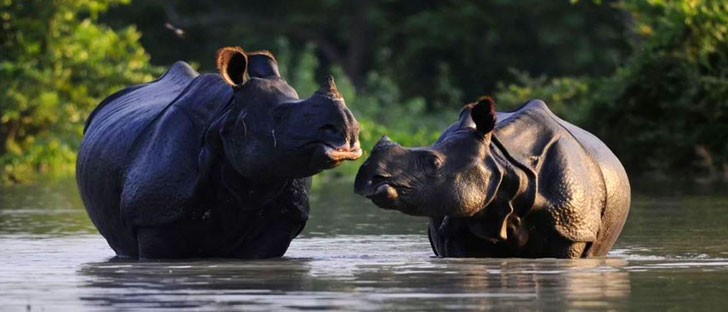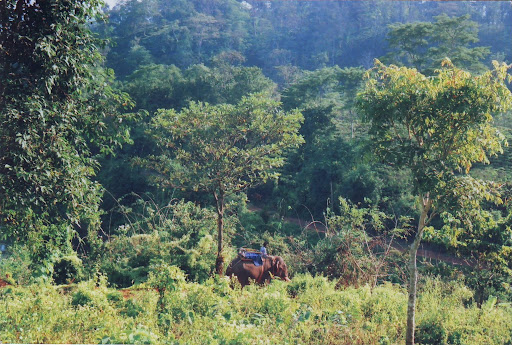Amchang Wildlife Sanctuary, covering an area of 78.64 sq. km, is located on the outskirts of Guwahati city in Assam. Despite its relatively small size, the sanctuary boasts a rich variety of mammals, birds, and reptiles, making it a must-visit destination for nature enthusiasts. This article aims to provide essential information about the sanctuary, its significance, and the importance of conservation efforts.
Declared a wildlife sanctuary by the Assam government on June 19, 2004, Amchang is situated in the far eastern part of Guwahati and lies within the East-Kamrup Forest Division of Kamrup district. Located just 15 km from Guwahati Railway Station, it offers a refreshing natural escape for visitors, combining scenic beauty with diverse wildlife.
The sanctuary is renowned for its rare and endangered animals and birds. Notable mammals found here include the Chinese pangolin, flying fox, slow loris, Assamese macaque, capped langur, hoolock gibbon, jungle cat, leopard cat, leopard, elephant, wild pig, sambar, barking deer, gaur, and porcupine. It is also home to the Tree Yellow butterfly (Gancana harina), a species native to Thailand, Malaysia, Singapore, and northeast India. Assam itself is home to over 750 species of butterflies and 360 species of moths.
Among the bird species spotted here are the lesser adjutant, greater adjutant, white-backed vulture, slender-billed vulture, khaleej pheasant, green imperial pigeon, and lesser pied hornbill. The sanctuary is also home to various reptiles, such as the Indian python, monitor lizard, and Indian cobra.
However, the sanctuary faces growing threats due to the rapid expansion of Guwahati, putting its natural resources under increasing pressure. In light of these challenges, it is crucial for the local community to support conservation efforts. The Assam Forest Department, along with government and non-governmental organizations, is working to safeguard this natural heritage. Public awareness and active participation are essential in preserving Amchang Wildlife Sanctuary for future generations.
History and Establishment
Historical Background of the Sanctuary
Amchang Wildlife Sanctuary, nestled on the outskirts of Guwahati, Assam, has a rich history intertwined with the region’s natural heritage. The area was traditionally a dense forest, home to diverse wildlife and flora, serving as a crucial habitat for many species. Over the years, the forest faced threats from urban expansion and human activities, prompting the need for its protection.
Formation and Declaration as a Wildlife Sanctuary in 2004
Recognizing the ecological importance of the area, the Assam government declared Amchang as a wildlife sanctuary in 2004. This move was aimed at preserving the unique biodiversity and providing a safe haven for endangered species. The sanctuary covers an area of approximately 78.64 square kilometers, encompassing three reserve forests: Amchang, South Amchang, and Khanapara.
Significance of the Name “Amchang”
The name “Amchang” holds cultural and historical significance. In the local Assamese language, “Amchang” is believed to be derived from the words “Am” (meaning mango) and “Chang” (meaning highland). This reflects the sanctuary’s landscape, characterized by its elevated terrain and the presence of mango trees. The name symbolizes the harmonious coexistence of nature and culture in this region.
Geography and Habitat
Description of the Terrain and Landscape
Amchang Wildlife Sanctuary is a picturesque expanse located on the eastern fringes of Guwahati, Assam. The sanctuary’s terrain is a blend of rolling hills, dense forests, and open grasslands. This diverse landscape creates a mosaic of habitats that support a wide variety of wildlife. The elevation varies, providing stunning vistas and a range of microhabitats for different species.
Types of Forests: Tropical Moist Deciduous and Semi-Evergreen
Amchang Wildlife Sanctuary is predominantly covered by tropical moist deciduous forests, characterized by a mix of broadleaf trees that shed their leaves seasonally. These forests are interspersed with patches of semi-evergreen forests, especially in the valleys and depressions. The semi-evergreen forests retain their foliage year-round, creating a lush, green canopy that supports a rich biodiversity. This combination of forest types ensures a continuous supply of food and shelter for the sanctuary’s inhabitants.
Major Rivers and Water Bodies Within the Sanctuary
Amchang Wildlife Sanctuary is crisscrossed by several streams and rivulets that originate from the surrounding hills. These water bodies are vital for the sanctuary’s ecosystem, providing essential hydration for both flora and fauna. The presence of these streams also supports a variety of aquatic life and attracts numerous bird species, making the sanctuary a haven for birdwatchers. The water bodies play a crucial role in maintaining the ecological balance and supporting the diverse wildlife that calls Amchang home.
Flora and Fauna
Flora
Dominant Plant Species: Amchang Wildlife Sanctuary is a lush haven of biodiversity, dominated by tropical moist deciduous forests. The sanctuary is home to towering sal trees, robust teak, and a variety of bamboo species. These forests provide a dense canopy that supports a myriad of life forms beneath.
Unique and Rare Vegetation: Among the sanctuary’s unique vegetation are several rare and medicinal plants. The undergrowth is rich with ferns, orchids, and herbs that are not only vital for the ecosystem but also hold significant medicinal value. These plants contribute to the sanctuary’s status as a biodiversity hotspot.
Fauna
Mammals: Amchang Wildlife Sanctuary is renowned for its diverse mammalian population. The sanctuary is a refuge for majestic elephants, often seen roaming in herds. Other notable mammals include the elusive Chinese pangolin, the nocturnal slow loris, and the playful Assamese macaque. The sanctuary also shelters the endangered hoolock gibbon and the stealthy leopards, making it a critical habitat for these species.
Birds: Birdwatchers find Amchang a paradise with its rich avian diversity. The sanctuary is home to the critically endangered white-backed vulture and slender-billed vulture. The great pied hornbill, with its striking casque, is a frequent sight, along with other species like the oriental pied hornbill and green imperial pigeon. These birds add vibrant colors and sounds to the sanctuary’s landscape.
Reptiles and Amphibians: Amchang Wildlife Sanctuary’s ecosystem is also rich in reptiles and amphibians. The sanctuary’s streams and ponds are habitats for various species of frogs and toads. Snakes and lizards are commonly spotted, contributing to the ecological balance. These creatures play crucial roles in controlling insect populations and maintaining the health of the ecosystem.
Tourism and Activities

Best Time to Visit
The ideal time to visit Amchang Wildlife Sanctuary is between November and April. During these months, the weather is pleasant, making it perfect for outdoor activities. The monsoon season, from June to September, brings heavy rainfall, which can make the trails slippery and challenging to navigate.
Popular Activities
Bird Watching: Amchang Wildlife Sanctuary is a paradise for bird enthusiasts. With over 120 species of birds, including the great pied hornbill and various migratory birds, early mornings are the best time to witness the avian diversity. The sanctuary’s serene environment provides a perfect backdrop for birdwatching.
Wildlife Safaris: Embark on a thrilling wildlife safari to explore the sanctuary’s rich fauna. Safaris offer a chance to spot elephants, leopards, and other wildlife in their natural habitat. Guided tours are available, providing insights into the sanctuary’s ecosystem and conservation efforts.
Trekking: For adventure seekers, Amchang offers several trekking trails that wind through its lush forests and hills. These treks range from easy to moderate difficulty, allowing visitors to immerse themselves in the sanctuary’s natural beauty. Trekking also provides opportunities to encounter various plant and animal species up close.
Guidelines for Visitors
To ensure minimal impact on the environment and preserve the sanctuary’s pristine condition, visitors are encouraged to follow these guidelines:
- Respect Wildlife: Maintain a safe distance from animals and avoid disturbing their natural behavior.
- No Littering: Carry all waste back with you and dispose of it properly. Use designated bins if available.
- Stay on Trails: Stick to marked paths to prevent damage to vegetation and reduce the risk of getting lost.
- Quiet Observation: Keep noise levels low to avoid startling wildlife and to enhance your own experience.
- No Feeding Animals: Feeding wildlife can disrupt their natural diet and behavior, leading to dependency on humans.
- Eco-Friendly Practices: Use biodegradable products and avoid single-use plastics to minimize environmental impact.
Future Prospects
Plans for Further Conservation and Development:
Amchang Wildlife Sanctuary, located on the eastern fringe of Guwahati, Assam, is a haven for diverse flora and fauna. Future conservation efforts aim to enhance the sanctuary’s biodiversity through habitat restoration and anti-poaching measures. The Assam government, in collaboration with local and international conservation organizations, plans to implement advanced monitoring systems and increase the sanctuary’s protected area. These initiatives will help safeguard endangered species like the Indian bison and the Chinese pangolin.
Potential for Eco-Tourism and Community Involvement:
Eco-tourism presents a significant opportunity for Amchang Wildlife Sanctuary. By promoting responsible tourism, the sanctuary can generate revenue that supports conservation efforts while providing educational experiences for visitors. Local communities can play a crucial role in this initiative by offering homestays, guided tours, and cultural programs. This involvement not only boosts the local economy but also fosters a sense of ownership and responsibility towards the sanctuary.
Importance of Continued Support and Awareness:
Sustained support and awareness are vital for the long-term success of conservation efforts at Amchang. Public awareness campaigns, educational programs in schools, and community workshops can help spread the importance of preserving this unique ecosystem. Additionally, partnerships with NGOs and corporate sponsors can provide the necessary funding and resources for ongoing projects. By engaging the broader community, we can ensure that Amchang Wildlife Sanctuary remains a thriving habitat for future generations.
Conclusion
Amchang Wildlife Sanctuary stands as a vital green oasis on the outskirts of Guwahati, offering refuge to a wide array of rare and endangered species. Its diverse ecosystem, home to mammals, birds, butterflies, and reptiles, makes it an important site for wildlife conservation and nature enthusiasts alike. However, as urbanization encroaches upon its boundaries, the sanctuary faces growing challenges in preserving its natural resources. The continued efforts of the Assam Forest Department, alongside public support and awareness, are crucial to safeguarding this unique wildlife sanctuary for future generations. Amchang is not just a place of natural beauty; it is a symbol of the need for balance between development and conservation.
Where is Amchang Wildlife Sanctuary located?
Amchang Wildlife Sanctuary is situated on the eastern outskirts of Guwahati, Assam, India, covering an area of approximately 78.64 square kilometers.
What types of wildlife can be found in the sanctuary?
The sanctuary is home to a diverse range of wildlife, including mammals like elephants, leopards, Chinese pangolins, Assamese macaques, and hoolock gibbons. Bird species such as the great pied hornbill and various migratory birds are also present.
What is the best time to visit Amchang Wildlife Sanctuary?
The optimal period to visit the sanctuary is from October to April, when the weather is pleasant and conducive for outdoor activities.
Are there trekking or safari options available for visitors?
Yes, visitors can engage in trekking and wildlife safaris within the sanctuary to explore its rich biodiversity.
How can I reach Amchang Wildlife Sanctuary from Guwahati?
The sanctuary is located about 15 kilometers from Guwahati Railway Station. Visitors can reach the sanctuary by hiring a taxi or using local transportation options.
Are there accommodation facilities within the sanctuary?
There are no accommodation facilities inside the sanctuary. Visitors typically stay in Guwahati and plan day trips to the sanctuary.
Is it necessary to hire a guide when visiting the sanctuary?
While not mandatory, hiring a guide is recommended to enhance the experience and ensure safety during treks and safaris.
What should visitors keep in mind to ensure a responsible visit?
Visitors should respect wildlife by maintaining a safe distance, avoid littering, stay on designated trails, keep noise levels low, refrain from feeding animals, and practice eco-friendly habits.
Are there any specific rules or regulations for visitors?
Visitors are expected to follow guidelines set by the Assam Forest Department, which include obtaining necessary permits, adhering to designated visiting hours, and following instructions provided by sanctuary authorities.
How does the sanctuary contribute to conservation efforts?
Amchang Wildlife Sanctuary plays a crucial role in preserving Assam’s biodiversity by providing a protected habitat for numerous species. Conservation initiatives focus on habitat restoration, anti-poaching measures, and community involvement to ensure the sanctuary’s sustainability.












